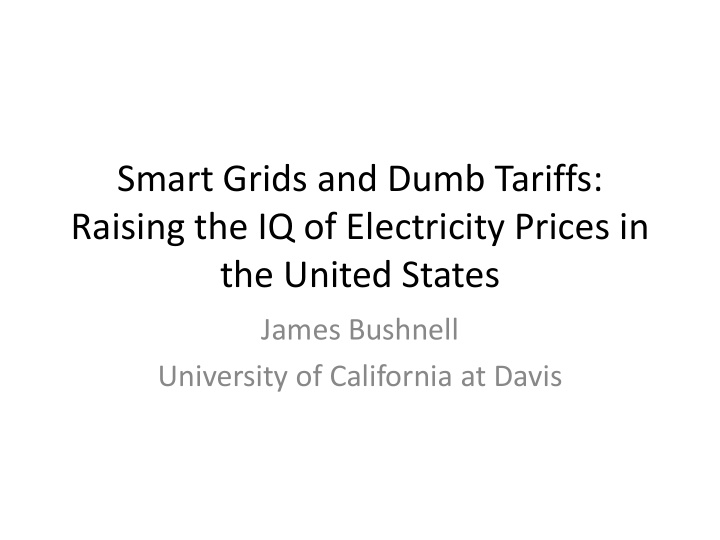



Smart Grids and Dumb Tariffs: Raising the IQ of Electricity Prices in the United States James Bushnell University of California at Davis
Outline • Background – (almost) Everybody loves smart-meters – But what do we do with them? • Models of Customer Behavior – Lessons learned from trials • Wholesale Demand Response in the US
Smart-Meters are Proliferating in the US Source: U.S. Energy Information Administration, Annual Electric Power Industry Report (Form EIA-861).
Forms of Dynamic Pricing • NOT Time-of-Use: TOU is time-varying, but not dynamic • Pay for demand reduction in emergency periods • Interruptible tariffs • Critical peak pricing (CPP) • Peak-time rebates (PTR) • Real-time pricing (RTP) – With hedging through customer forward power purchases – With compensation for lost cross-subsidy – With direct load control features • CPP and PTR programs in widening use • RTP in use some places for industrial, but rare
What Behavioral Economics Can Tell Us • Rational Inattention • Social Norms • Defaults – Status quo bias
Rational Inattention – There are limits on how much information the human (American?) brain can process. – Individuals are forced to prioritize which economic decisions to focus on • Refinancing mortgage, where to buy petrol, brew your own coffee. – Electricity consumption has typically been low priority in this competition for attention • In most cases this is “rational” given the constraints on attention. – Periodic high prices can force customers to invest in knowing their consumption. – Lowering the “costs” to paying attention to electricity consumption can yield large improvements in response • Jessoe and Rapson (2013) show customers with in-home displays giving consumption information are 3 times as responsive to critical peak pricing.
Defaults • Traditional economic view is that “the customer is always right” – a.k.a. revealed preference • If customers don’t buy CFL’s, its because they dislike them more than the cost savings. • But there are many cases where choices are driven by starting points (defaults) – Retirement accounts, diet and nutrition, organ donations. – So observed choices reveal an inclination not to change more than a preference for a specific option or product. • For electricity pricing, customers who begin on price incentives are much more likely to stay there than. – Choice- neutral defaults (“libertarian paternalism”) – SMUD experiment (George and Potter, 2013) finds much more participation, and aggregate reductions, amongst default “in” customers in California.
What Recent Work Tells Us About Dynamic Pricing • Time-of-Use rates not that helpful – Traditional studies have overvalued their impact • Default options are important – Opt-in programs yield much less participation than opt-out programs • Information is important – Customers need help translating energy use to pricing – Reminders of price and use keep information salient • Incentives do matter – Rebate programs are more popular, but more vulnerable to moral hazard (consumer manipulation)
Demand Response: U.S. Provision of Price Response at the Wholesale Level • FERC has strongly pushed ISO’s to foster “demand response” as a wholesale product. – Perhaps in response to frustration at lack of progress at the retail level – Wholesale DR aggregators are paid wholesale prices to “reduce” demand of their clients. • Several problematic aspects to this approach. – Baseline problem is severe – Adverse selection problems with voluntary participation • FERCs implementation of DR has made these problems even worse.
DR and FERC order 745 • Order 745 requires DR be compensated at full LMP (wholesale price). – This ignores the fact that not consuming power saves consumers from paying the retail price. • Example: value of “lost load” is $150/ MWh to consumers, retail price r is $100, wholesale price is $125. – Consume and benefit is 150 – 100 = 50 – “Sell” to ISO (not consume) and benefit is 125. • Order 745 encourages consumers to shed even high value load. – Rewards generation behind the meter with more value than in front of it.
Summary • Mounting evidence that customers do respond to dynamic prices – Need not be full RTP, but what problem is being addressed? • Participation very much depends upon default options – What are implications for retail choice environments with multitude of tariff options? • A wholesale market model to DR creates incentive and measurement problems – At least for energy reduction, more promise for provision of ancillary services. – Again, what problem are we trying to solve?
Recommend
More recommend